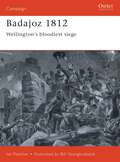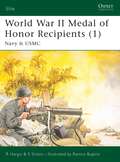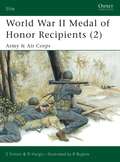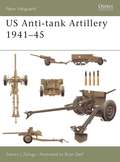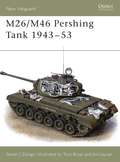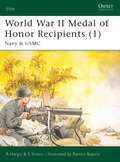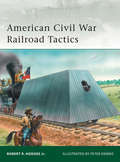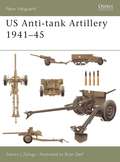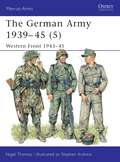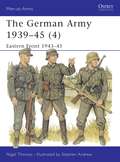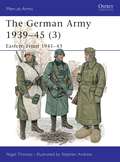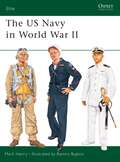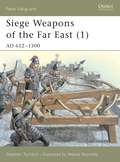- Table View
- List View
Badajoz 1812: Wellington's bloodiest siege (Campaign #65)
by Bill Younghusband Ian FletcherThe storming of Badajoz was an epic action which involved Wellington's infantry in some of the most savage hand-to hand fighting of the whole Peninsular War. At appalling cost in a nightmare assault during the night of the 6 April 1812, Wellington's soldiers hacked their way over the bodies of their dead and wounded and through the huge medieval walls of the town. These were held with great tenacity, skill and courage by a resolute French and German garrison. Having stormed the town the battle-crazed army went berserk and the horrors of the sacking which followed, as much as the sublime courage of the attackers, have passed into legend.
Modelling the Mitsubishi A6M Zero (Osprey Modelling)
by Brian CrinerThe A6M Rei Shiki Sento Ki (meaning Type Zero fighter) was the result of an order by the Imperial Japanese Navy for a low-wing monoplane with superior speed, range, climbing powers, and manoeuvrability. It famously served as a fighter escort during the attack on Pearl Harbor in December 1941, and ended the war as the kamikaze plane of choice. This book provides a detailed guide to modelling this popular aircraft across a variety of scales, and features an A6M2-N Rufe, a kamikaze A6M5c, an A6M2 model 21, and a captured A6M5b of TAIC #7, as well as a gallery and walkaround section.
Modelling the F4F Wildcat (Osprey Modelling #39)
by Mark GliddenThe F4F Wildcat was an aircraft of the type of which legends are made. Without the handling performance that made the Japanese Zero so famous, it was well regarded for its ruggedness and firepower and, in the hands of a skilled pilot who understood both its strengths and weaknesses, it was capable of holding its own against the best that its opponents had to offer. This book details projects that encompass four variants of the F4 Wildcat. As they were supplied to a number of air forces during the war, including the RAF, there is a wide range of markings available to modellers which are also dealt with in detail. Covering a range of modelling abilities from a beginner's first build to an expert scratch-building extras, this book is illustrated with full-colour step-by-step photographs.
World War II Medal of Honor Recipients: Navy & USMC (Elite #92)
by Ramiro Bujeiro Robert Hargis Starr SintonThe Medal of Honor is the highest military award that can be bestowed on personnel in the United States' Armed Forces. This book is the first of two titles looking at the recipients of the Medal of Honor during World War II. It covers Navy and Marine Corps awardees in all theaters of war, from the attack on Pearl Harbor in 1941 to the brutal fighting on Iwo Jima in 1945. Among the inspiring stories told are those of Signalman 1st Class Douglas Munro, the only Coast Guardsman to ever receive the Medal of Honor, and Commander Antrim, who faced almost certain death to save fellow prisoners in a Japanese prisoner of war camp.
World War II Medal of Honor Recipients: Army & Air Corps (Elite)
by Ramiro Bujeiro Robert Hargis Starr SintonThe Medal of Honor is the highest award for valor in action against an enemy force that can be awarded to personnel in the United States' Armed Forces. From the early fighting in the Philippines through the D-Day landings in Northwest Europe to the final assaults in the Pacific, this book looks at the brave US soldiers and airmen who were awarded the Medal of Honor for their actions in the face of danger. It tells the exciting combat stories of such famous figures as the film star Audie Murphy, one of the most decorated US soldier of WWII, alongside less well-known awardees.
French Soldier in Egypt 1798–1801: The Army of the Orient (Warrior #77)
by Christa Hook Terry CrowdyThis book concentrates on the dramatic experiences of Napoleon's Army of the Orient in Egypt and the Holy Land. The fighting of the Mamelukes and Turks are covered in depth, detailing desert combat, siege warfare, cavalry skirmishes and the suppression of uprisings. It examines the French treatment of prisoners as well as the fate of captured Frenchmen, and describes caring for the wounded, outbreaks of bubonic plague, and the terrible retreat from Acre in 1799, in accounts by the men who were there. The experiences of infantry, cavalry and sea soldiers of Napoleon's Army of the Orient are brought vividly back to life.
US Anti-tank Artillery 1941–45 (New Vanguard #107)
by Steven J. Zaloga Brian DelfThe US Army's development of the 37mm anti-tank gun began in response to needs identified during the Spanish Civil War. By the time it entered service in Tunisia in 1943, the gun was already obsolete, and the US began the licensed manufacture of the British 6-pdr in the hope of finding a quick solution to its artillery requirements. This in turn proved unequal to the demands of warfare in France in 1944, and further anti-tank measures were developed – rocket propelled grenades for infantry use, and weapons designed specifically for use by the Tank Destroyer Force.
M26/M46 Pershing Tank 1943–53 (New Vanguard #35)
by Steven J. Zaloga Jim Laurier Tony BryanFrom the moment that the M4 Sherman had been matched against German Panther and Tiger tanks, the American tank crews had known that their vehicles were outclassed by the opposition. What was needed was a more powerful tank, more heavily armed and armored, that could take-on the powerful German panzers on a more equal footing. Although it took time to develop by the latter months of the war numbers of M26 Pershing tanks were reaching the frontline US armored units. Well armored and with a powerful 90mm gun the Pershing was a match for any tank in the German order of battle.
World War II Medal of Honor Recipients: Navy & USMC (Elite #92)
by Ramiro Bujeiro Robert Hargis Starr SintonThe Medal of Honor is the highest military award that can be bestowed on personnel in the United States' Armed Forces. This book is the first of two titles looking at the recipients of the Medal of Honor during World War II. It covers Navy and Marine Corps awardees in all theaters of war, from the attack on Pearl Harbor in 1941 to the brutal fighting on Iwo Jima in 1945. Among the inspiring stories told are those of Signalman 1st Class Douglas Munro, the only Coast Guardsman to ever receive the Medal of Honor, and Commander Antrim, who faced almost certain death to save fellow prisoners in a Japanese prisoner of war camp.
World War II Medal of Honor Recipients: Army & Air Corps (Elite #95)
by Ramiro Bujeiro Robert Hargis Starr SintonThe Medal of Honor is the highest award for valor in action against an enemy force that can be awarded to personnel in the United States' Armed Forces. From the early fighting in the Philippines through the D-Day landings in Northwest Europe to the final assaults in the Pacific, this book looks at the brave US soldiers and airmen who were awarded the Medal of Honor for their actions in the face of danger. It tells the exciting combat stories of such famous figures as the film star Audie Murphy, one of the most decorated US soldier of WWII, alongside less well-known awardees.
The Fortifications of Verdun 1874–1917 (Fortress #103)
by Brian Delf Clayton DonnellThe ring of fortifications protecting the city of Verdun on the Meuse River would become critical in the infamous battle of World War I. This book examines these fortifications, including the famous forts of Douaumont and Vaux that saw some of the fiercest fighting during the battle.
French Soldier in Egypt 1798–1801: The Army of the Orient (Warrior #77)
by Christa Hook Terry CrowdyThis book concentrates on the dramatic experiences of Napoleon's Army of the Orient in Egypt and the Holy Land. The fighting of the Mamelukes and Turks are covered in depth, detailing desert combat, siege warfare, cavalry skirmishes and the suppression of uprisings. It examines the French treatment of prisoners as well as the fate of captured Frenchmen, and describes caring for the wounded, outbreaks of bubonic plague, and the terrible retreat from Acre in 1799, in accounts by the men who were there. The experiences of infantry, cavalry and sea soldiers of Napoleon's Army of the Orient are brought vividly back to life.
American Civil War Railroad Tactics (Elite #171)
by Peter Dennis Robert R. Hodges Jr.The American Civil War was the world's first full-blown 'railroad war'. The well-developed network in the North was of great importance in serving the Union armies' logistic needs over long distances, and the sparser resources of the South were proportionately even more important. Both sides invested great efforts in raiding and wrecking enemy railroads and defending and repairing their own, and battles often revolved around strategic rail junctions. Robert Hodges reveals the thrilling chases and pitched battles that made the railroad so dangerous and resulted in a surprisingly high casualty rate. He describes the equipment and tactics used by both sides and the vital supporting elements – maintenance works, telegraph lines, fuel and water supplies, as well as garrisoned blockhouses to protect key points. Full-colour illustrations bring the fast-paced action to life in this fascinating read; a must-have volume for rail and Civil War enthusiasts.
US Anti-tank Artillery 1941–45 (New Vanguard #107)
by Steven J. Zaloga Brian DelfThe US Army's development of the 37mm anti-tank gun began in response to needs identified during the Spanish Civil War. By the time it entered service in Tunisia in 1943, the gun was already obsolete, and the US began the licensed manufacture of the British 6-pdr in the hope of finding a quick solution to its artillery requirements. This in turn proved unequal to the demands of warfare in France in 1944, and further anti-tank measures were developed – rocket propelled grenades for infantry use, and weapons designed specifically for use by the Tank Destroyer Force.
M26/M46 Pershing Tank 1943–53 (New Vanguard #35)
by Steven J. ZalogaFrom the moment that the M4 Sherman had been matched against German Panther and Tiger tanks, the American tank crews had known that their vehicles were outclassed by the opposition. What was needed was a more powerful tank, more heavily armed and armored, that could take-on the powerful German panzers on a more equal footing. Although it took time to develop by the latter months of the war numbers of M26 Pershing tanks were reaching the frontline US armored units. Well armored and with a powerful 90mm gun the Pershing was a match for any tank in the German order of battle.
German V-Weapon Sites 1943–45 (Fortress #72)
by Hugh Johnson Steven J. ZalogaDesigned to change the course of the war, the V weapons required ambitious plans to defend their expensive and complicated launch sites. Steven J Zaloga describes the configuration and planned deployment of heavy missile sites, as well as the unique Allied tactics developed to counter this threat, including a remote-control version of the B-17 bomber. From the V-1 ski sites to the mobile basing employed by the V-2 units and the other secret weapons bases like the 'V-3' high-pressure gun at Mimoyeques, this book examines the impact of these weapon systems and defences not only on the war but on modern weaponry. With many of the sites described still surviving today, this is a perfect companion for a tour of the V weapon sites built during World War II.
Pictish Warrior AD 297-841 (Warrior #50)
by Angus Konstam Paul WagnerFirst mentioned by name in AD 297, the Picts inhabited Northern Britain from the end of the 3rd century AD to the 9th. They rose to power in the devastation following Emperor Septimus Severus's repression of the Caledonians in AD 208, and dominated Northern Britain for over 500 years, before vanishing mysteriously. The Picts represent a high point of Celtic civilisation, remaining free and unconquered beyond the borders of the Roman world, and rising to become the first barbarians to form a recognisable 'nation'. This title takes a detailed look at their origins, and examines Pictish heroic and warrior society, covering education and training, appearance and equipment, the status of women, and the experience of battle.
The German Army 1939–45: Western Front 1943–45 (Men-at-Arms #336)
by Nigel ThomasThis book covers the high command, the developments in unit organisation, the campaigns and the uniforms and equipment of the German Army in the last two years of the war in North-West Europe and Italy. Despite the huge pressure of fighting on three fronts, ever-worsening shortages of manpower and equipment, and Allied command of the skies, Germany's decimated divisions fought on with impressive skill and determination. This period also saw a fascinating mixture of obsolescent, newly designed, and field-made combat clothing which gave the German soldier a radically different appearance from his predecessor of just five years before. Men-at-Arms 311, 316, 326, 330 and 336 are also available in a single volume special edition titled 'German Army in World War II'.
The German Army 1939–45: Eastern Front 1943–45 (Men-at-Arms)
by Nigel Thomas Stephen AndrewIn early 1943 the annihilation of the 6th Army at Stalingrad marked the irreversible turning-point of the war in the East. Despite occasional local successes gained in the face of great odds – testimony to the Wehrmacht's extraordinary resilience – from now on Germany was on the defensive. Despite Hitler's damaging interference the quality of German field leadership, and of new weapons, remained high; but each new Soviet offensive pushed the front line closer to – and finally, across – the borders of the Reich. In this fourth title of their sequence author and artist describe and illustrate the developments in unit organization, uniforms and equipment during 1943–45, including information on European and Eastern volunteer units; text and illustrations are supported by detailed tables. Men-at-Arms 311, 316, 326, 330 and 336 are also available in a single volume special edition titled 'German Army in World War II'.
The German Army 1939–45: Eastern Front 1941–43 (Men-at-Arms #326)
by Nigel Thomas Stephen AndrewOperation Barbarossa, the attack on the Soviet Union, commenced on 22 June 1941. It became the biggest conflict in military history, with some three million German troops and about 900,000 allies facing almost 4.7 million Soviet troops. The effects would colour postwar European history for the next 50 years. This title examines the history of the conflict, and the organisation, uniforms and insignia of the German Army on the Eastern Front from 1941-43. The book contains numerous illustrations and photographs throughout, incuding eight fine full-page colour plates by Stephen Andrew. Men-at-Arms 311, 316, 326, 330 and 336 are also available in a single volume special edition titled 'German Army in World War II'.
The US Navy in World War II (Elite #80)
by Mark HenryIn 1941 the US Navy had 17 battleships of which eight would be knocked out on the first day of the war four aircraft carriers, and about 340,000 men including reservists. Pearl Harbor so weakened it that it was unable to prevent the Japanese capture of the Philippines and a vast sweep of Pacific islands. By 1945 it was the strongest navy the world had ever seen, with nearly 100 carriers, 41,000 aircraft and 3.3 million men; the unrivalled master of air-sea and amphibious operations, it was poised to invade Japan's home islands after reducing her fleet to scrap and her Pacific empire to impotence and starvation. This extraordinary story is illustrated here with dramatic photos, and nine meticulous colour plates showing a wide range of USN uniforms.
Vietnam Firebases 1965-73: American and Australian Forces (Fortress #58)
by Peter Dennis Randy E. FosterArtillery fire support bases of the Freeworld forces played a critical role in the conduct of operations during the Vietnam War. They served to lay down high-volume fire on enemy firing sites, supported friendly infantry operations, and executed harassing fire missions where exact targets were not known. But the firebases themselves which housed a range of other facilities such as troop shelters, surveillance radars and command centers had to be defended against ground attack, and as a result became significant fortifications in their own right. This book describes the design, development and operational history of the fire support bases throughout the conflict.
French Napoleonic Infantry Tactics 1792–1815 (Elite #159)
by Peter Dennis Paddy GriffithBonaparte's Grande Armée, one of the most renowned battle-winning machines in history, evolved from a merging of the professional army of the Ancien Régime and the volunteers and conscripts of the Revolutionary levée en masse – although the contribution of the former is often underestimated. A leading authority on the history of tactics draws here on original drill manuals and later writings to explain how the French infantry of 1792–1815 were organized for fire and movement on the battlefield. Illustrated with clear diagrams and relevant paintings and prints, and specially prepared colour plates, this text brings the tactical aspects of eight battles vividly to life.
Siege Weapons of the Far East: AD 612–1300 (New Vanguard #43)
by Stephen Turnbull Wayne ReynoldsThe prevalence of particular fortress types in medieval China, Mongolia, Japan and Korea demanded the evolution of different modes of siege warfare in each country. The wealthy walled towns of China, the mountain fortresses of Korea and the military outposts of Japan each presented different challenges to besieging forces, and this book reveals the diversity of tactics that were developed to meet these challenges. Most of the Far Eastern weaponry of this period originated in China, but was adapted to fit the demands of siegecraft across the region and the individual strengths and weaknesses of each piece of machinery are studied here.
Siege Weapons of the Far East: AD 960–1644 (New Vanguard #44)
by Stephen Turnbull Wayne ReynoldsFrom the 11th century AD, East Asian armies made increasing use of exploding missiles and siege cannon to reduce the fortifications of their enemies. Some of these weapons were very similar to those used in Europe for example, the heavy siege cannon used in the siege of P'yongyang during the Japanese invasion in the late 16th century. Others, like the Korean hwach'a carts mounting over a hundred rockets that were used to bombard the Japanese at Haengiu in 1593, were very different from their European contemporaries. This book details the design and use of the wide range of weaponry available during this period.
